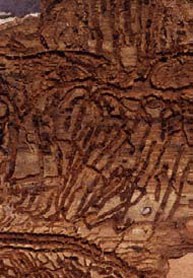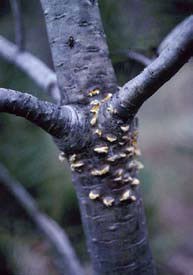|
Forest pests result when non-native insects and diseases are introduced into an ecosystem and lead to environmental or economic damage. So, what does this mean to Yosemite's visitors? People bringing firewood with them can introduce pests accidentally to the park. Park officials, therefore, ask visitors not to transport outside firewood inside the park because pests often survive inside wood where they can’t be seen. (Scroll down to see where visitors are permitted to gather wood in the park.) Currently, 16 pests concern park foresters. Insects and Diseases that Threaten Yosemite

Forest pest problems have grown throughout the past 150 years. The latest invader to the wider California region is the goldspotted oak borer found in Southern California's oak trees (but not yet in Yosemite's, luckily). Anecdotal reports suggest this oak borer might have been brought into the state on oak firewood from Mexico during in the late 1990s. Found previously in southeast Arizona, southern Mexico and northern Guatemala, it was collected in 2004 in San Diego County. Confirmed hosts are mature specimens of coast live oak, canyon live oak and California black oak. Another recent pest example is a pathogen called sudden oak death—found in coastal California locations. Its presence has lead to a quarantine of firewood and soil materials from the following counties: Alameda, Contra Costa, Humboldt, Lake, Marin, Mendocino, Monterey, Napa, San Francisco, San Mateo, Santa Clara, Santa Cruz, Solano, and Sonoma. Yosemite officials ask visitors coming from affected counties to adhere to the state- and federal-issued quarantine to minimize sudden oak death. Throughout the United States, virtually all dominant tree species in eastern forests, major species in western forests, and an increasing number of species in subtropical forests are under siege by forest pests. (Worried about nearby emerald ash borer infestations? Shenandoah National Park has banned bringing firewood on March 1, 2010.) These forest pests impact urban sites, too, as shown by the destruction of urban trees by Dutch elm disease, gypsy moth, and the light brown apple moth. While Yosemite has been spared from a critical level of infestation of non-native forest pests, park managers must work to prevent an outbreak in the future. 
Do Pests Change Ecosystems? The impact of non-native insects and diseases extends far beyond their effects on the host species they attack. Although damage is inflicted on the host species (like the fungus which causes sudden oak death kills the oak tree), the impact also extends to the associated plants and animals. Some native species depend on a particular tree species or forest type and are threatened with extinction when that tree disappears. The destruction of food-bearing tree species, such as whitebark pine, interrupts food chains and forest energy cycles. (Read about whitebark pine's 2011 listing as a candidate species on the Endangered Species Act due to the exotic white pine blister rust.) The destruction of riparian hardwoods by sudden oak death could increases stream water temperatures and reduces the amount of habitat for native trout. Because forest ecosystems extend below ground level, other damage can occur. In a forest's understory, for example, flowering dogwoods contribute a significant amount of calcium to the soil. Ecological studies have shown that above-ground changes in tree species composition and size affect underground food and energy webs with unknown long-term effects. 
How Are Pests Introduced? Trade and travel, globally and locally, brings increased potential for the introduction of non-native insects and diseases because insects and pathogens "hitchhike" on commercial shipments of goods and plants, and even on packing material. Recent establishments of serious pests in American forests-such as the emerald ash borer, sudden oak death, and koa wilt-were all introduced in this way. Because non-native pests developed elsewhere, they often have no naturally-occurring predators in their new "home." This can allow them to spread unchecked. What Is Yosemite National Park Doing about Forest Pests? It is much easier to prevent the introduction of a forest pest than it is to control an infestation after it has been introduced. Early detection is also important in managing a spread. Park managers are conducting aerial surveys, monitoring traps and forest health, identifying potential for introduction of non-native insects and diseases, and educating the public in order to prevent any introductions from occurring. How Can Visitors Help Prevent the Spread of Forest Pests?
How Can Visitors Properly Obtain Wood in the Park? It's permitted to gather downed wood in the park for personal use. It's prohibited, however, to gather wood in certain areas: in Yosemite Valley, in Sequoia groves, and above 9,600-feet elevation. (Note: Downed wood gathered in park areas outside the prohibited areas is allowed to be brought into the Valley as firewood.) Wood may also be available for sale by the park concessioner. Campfires and Air QualityCampfires may be built using established fire rings located in developed campgrounds. Campfires in Yosemite Valley are limited to the hours between 5-10 p.m. May 1-Sept. 30 to help protect air quality. Wood PermitsPermits are available for anyone to collect wood from wood lots in Yosemite National Park. Wood lots are located in El Portal, Foresta, Hodgdon Meadow, and Wawona. Permits are issued at fiscal office in Mariposa (209/379-1863). Call before going to the office. Wood is for personal use only—not for sale or exchange. Cost is $10 per cord (6 cords per year maximum). Where to Learn More
|
Last updated: July 25, 2024
